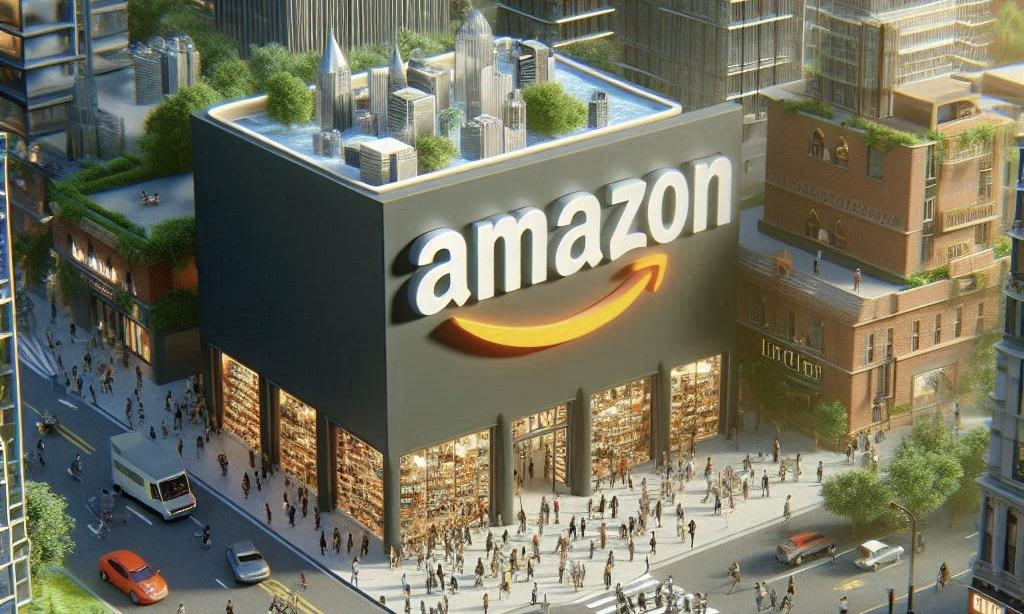Amazon's second-quarter online sales growth slowed as cautious consumers opted for cheaper purchases, leading to an 8% share drop. Despite beating profit and cloud computing sales estimates, Amazon's forecast for current-quarter sales fell below Wall Street expectations, disappointing investors.
Amazon Shares Drop 8% as Consumers Opt for Cheaper Goods Despite Strong Cloud Sales Performance
Amazon.com reported a slowdown in online sales growth for the second quarter, noting that cautious consumers were opting for cheaper purchases, which led to an almost 8% drop in shares. This decline occurred despite the company exceeding analyst estimates for second-quarter profit and cloud computing sales. Amazon's shares had gained over 20% this year through the session close on August 1.
Still, investors were disappointed with the company's forecast for current-quarter sales, which fell below Wall Street expectations.
Brian Olsavsky, Amazon's CFO, explained to reporters that consumers continued to be cautious with spending and were looking for deals, with lower-priced products selling briskly. CEO Andy Jassy concurred, stating that customers were trading down on price whenever possible. Amazon's online retail business has faced increased competition from budget retailers like Temu and Shein, which directly offer various goods at low prices from China. These comments mirrored those from companies like Mondelez, PepsiCo, and Kraft, highlighting American consumers' challenges.
Amazon’s online store sales rose 5% in the second quarter to $55.4 billion, compared to a 7% growth in the first quarter. An analyst noted that slowing retail sales growth drove the post-market shares sell-off. However, Charles Rogers, an analyst at M Science, highlighted the positive momentum in cloud growth, a significant aspect of Amazon's business. He mentioned that while the retail aspect weighed on the stock, cloud growth had a clear positive trend.
AWS Revenue Surges 19% as Amazon's Prime Day Shatters Records, Despite Consumer Spending Challenges
In a release announcing the results, according to Reuters, Jassy emphasized the continued re-acceleration in AWS growth. Amazon Web Services (AWS), Amazon's cloud business, reported a 19% increase in revenue to $26.3 billion for the second quarter, surpassing market estimates.
Olsavsky noted that predicting third-quarter performance took a lot of work due to events like the presidential election and the Olympics in Paris distracting consumers. However, he mentioned that Amazon’s Prime Day in July was a major success, being its “biggest ever.” This successful event is a testament to Amazon's ability to attract and engage consumers, though specifics were not provided.
Kraft recently stated that it must offer more entry-level price points and expand its range of Oscar Mayer products at dollar stores to cater to value-seeking shoppers.
Like other big tech companies, Amazon is increasing capital expenditures to invest in AI infrastructure and development. Olsavsky reported that spending in the first six months of this year was about $30.5 billion, suggesting about $16.5 billion was spent in the second quarter. Amazon is developing its large language models and has introduced a chatbot named Rufus to help customers with purchasing decisions. Google's parent company, Alphabet, and Microsoft recently cautioned investors about elevated yearly expenses to support AI software and services development.
For the third quarter, Amazon expects revenue between $154.0 billion and $158.5 billion, compared with analysts' average estimate of $158.24 billion. The company also missed estimates for advertising sales, a closely watched metric, reporting $12.8 billion in the quarter against an average estimate of $13 billion. Despite this, Olsavsky expressed satisfaction with the advertising results, noting a 20% growth in sales for the quarter.



 Apple iPhone Demand Surges Ahead of Tariff Hike, Shares Tumble
Apple iPhone Demand Surges Ahead of Tariff Hike, Shares Tumble  Peabody Reviews $3.78B Anglo American Coal Deal After Mine Fire
Peabody Reviews $3.78B Anglo American Coal Deal After Mine Fire  LG Energy Solution Q1 Profit Soars 138% Boosted by U.S. Tax Credits
LG Energy Solution Q1 Profit Soars 138% Boosted by U.S. Tax Credits  Japan Stocks Plunge Amid Trump’s New Tariffs and Auto Import Crackdown
Japan Stocks Plunge Amid Trump’s New Tariffs and Auto Import Crackdown  Anglo American Urges Faster Permits in Chile to Tackle Looming Copper Supply Gap
Anglo American Urges Faster Permits in Chile to Tackle Looming Copper Supply Gap  Texas Investigates WK Kellogg Over “Healthy” Claims on Cereals With Artificial Dyes
Texas Investigates WK Kellogg Over “Healthy” Claims on Cereals With Artificial Dyes  Levi Strauss Beats Earnings Estimates, Holds Steady Despite Tariff Concerns
Levi Strauss Beats Earnings Estimates, Holds Steady Despite Tariff Concerns  Universal Studios to Open First European Theme Park in UK by 2031
Universal Studios to Open First European Theme Park in UK by 2031  Toby Carrodus on the Complementary Future of Human Skills and AI
Toby Carrodus on the Complementary Future of Human Skills and AI  TikTok Deal Stalls Amid Trump’s Tariffs and China’s Retaliation
TikTok Deal Stalls Amid Trump’s Tariffs and China’s Retaliation  US Senators Question Microsoft and Google Over AI Cloud Partnerships
US Senators Question Microsoft and Google Over AI Cloud Partnerships  Medicare Declines Coverage Expansion for Obesity Drugs Like Wegovy and Zepbound
Medicare Declines Coverage Expansion for Obesity Drugs Like Wegovy and Zepbound  China’s Teapot Refiners See Modest Recovery Amid Sanctions and Weak Fuel Demand
China’s Teapot Refiners See Modest Recovery Amid Sanctions and Weak Fuel Demand  Trump Slams TSMC Subsidy, Threatens 100% Tax Without U.S. Manufacturing
Trump Slams TSMC Subsidy, Threatens 100% Tax Without U.S. Manufacturing  Telegram Fined $80K by Moscow Court for Extremist Content Refusal
Telegram Fined $80K by Moscow Court for Extremist Content Refusal  Apple Stock Falls to 11-Month Low Amid Escalating U.S.-China Trade War
Apple Stock Falls to 11-Month Low Amid Escalating U.S.-China Trade War  Indigenous Communities Seek Role in Chile’s Lithium Boom
Indigenous Communities Seek Role in Chile’s Lithium Boom 





























